William Elford Leach FRS was an English zoologist and marine biologist.

Thomas Say was an American entomologist, conchologist, and herpetologist. His studies of insects and shells, numerous contributions to scientific journals, and scientific expeditions to Florida, Georgia, the Rocky Mountains, Mexico, and elsewhere made him an internationally known naturalist. Say has been called the father of American descriptive entomology and American conchology. He served as librarian for the Academy of Natural Sciences of Philadelphia, curator at the American Philosophical Society, and professor of natural history at the University of Pennsylvania.

The hooked squid, family Onychoteuthidae, currently comprise about 20–25 species, in six or seven genera. They range in mature mantle length from 7 cm to a suggested length of 2 m for the largest member, Onykia robusta. The family is characterised by the presence of hooks only on the tentacular clubs, a simple, straight, funnel–mantle locking apparatus, and a 'step' inside the jaw angle of the lower beak. With the exception of the Arctic Ocean, the family is found worldwide.

Charles Alexandre Lesueur was a French naturalist, artist, and explorer. He was a prolific natural-history collector, gathering many type specimens in Australia, Southeast Asia, and North America, and was also responsible for describing numerous species, including the spiny softshell turtle, smooth softshell turtle, and common map turtle. Both Mount Lesueur and Lesueur National Park in Western Australia are named in his honor.

Leachia is a genus containing eight species of glass squids. The genus was formerly divided into two subgenera: Leachia and Pyrgopsis, but is no longer.
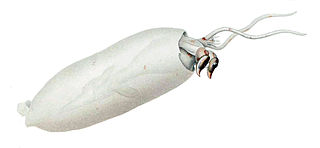
Taoniinae is a subfamily containing ten genera of glass squids.
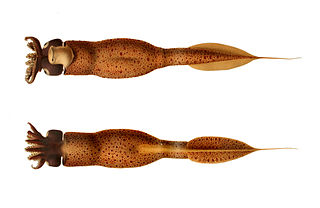
Taonius is a small genus of glass squid. Although it comprises only three recognised species, it has been suggested there may be as many as five species. Taonius borealis is found in the North Pacific Ocean and Taonius pavo is found in the Atlantic and possibly the south-western Indian Ocean.

Liocranchia is a genus of glass squid from the family Cranchiidae. They are moderate-sized with a long, spindle-shaped mantle which tapers to a point at the rear and they can attain mantle lengths of 250 millimeters (9.8 in). The species in Liocranchia have a cosmopolitan distribution in tropical and subtropical oceans although it has been suggested that on especies, Liocranchia reinhardti is associated with land masses. In seas off Hawaii waters, L. reinhardti undergoes vertical migrations while L. valdiviae occurs in deep water and is sedentary. They are eaten by many oceanic predator species.
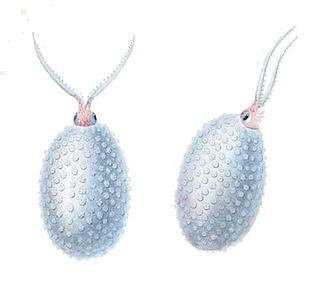
Cranchia scabra is a species of glass squid. It is the only species in the genus, and is fairly small. The mantle is covered by large, multi-pointed cartilagenous tubercles. When disturbed, the squid often pulls its head and arms into the mantle cavity and folds its fins tightly against the mantle to form a turgid ball. The tubercules, presumably, provide some type of protection, but it is unclear what predators are affected and how. In addition, the squid may ink into the mantle cavity, making the ball opaque. This was thought to be an aberrant behavior due to the stress and confinement of shipboard aquaria, until the same inking behavior was seen in cranchiids from submersibles. The function of this behavior is unknown.
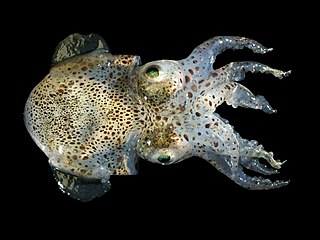
Sepiola is a genus of bobtail squid comprising around 15 species:

Eledone is a genus of octopuses forming the only genus in the family Eledonidae. It is mainly distributed in the northern and southern Atlantic Ocean, with one species, E. palari, described from the southwestern Pacific Ocean and eastern Indian Ocean in waters around Indonesia and Australia and another, E. microsicya, from the western Indian Ocean. One species, E. thysanophora, is now regarded as a synonym of the brush-tipped octopus.

Atlanta is a genus of pelagic marine gastropod molluscs in the family Atlantidae. They are sometimes called heteropods.

Carinaria is a genus of medium-sized floating sea snails, pelagic gastropod molluscs in the family Carinariidae.
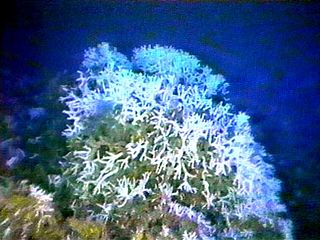
Oculina is a genus of colonial stony coral in the family Oculinidae. These corals are mostly found in the Caribbean Sea, the Gulf of Mexico and Bermuda but some species occur in the eastern Pacific Ocean. They occur at depths down to 1000 metres.

Onykia is a genus of squids in the family Onychoteuthidae. Due to similarities between the genera, several recent authors consider the genus Moroteuthis a junior synonym of Onykia. The type species is Onykia carriboea, the tropical clubhook squid.

Oxygyrus keraudrenii is a species of sea snail, a holoplanktonic marine gastropod mollusk in the family Atlantidae.
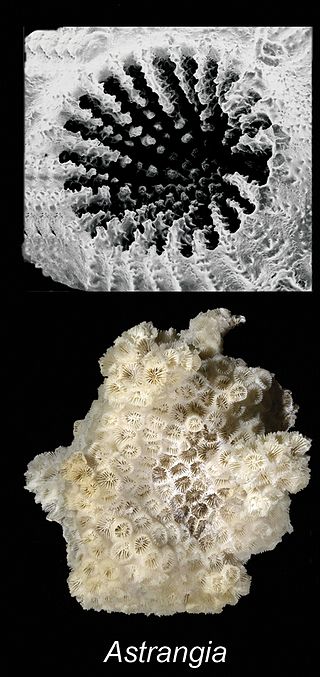
Astrangia is a genus of stony corals in the family Rhizangiidae. Members of this genus are non-reef building corals and are found in the Atlantic and Indo-Pacific Oceans. They are solitary corals with large polyps and are found in clumps. They reproduce from stolons. The corallites are small with simple toothed septa.
Firoloida is a monotypic genus of pelagic marine gastropod mollusc in the family Pterotracheidae, with the only species in the genus being Firoloida desmarestia. This shell-less mollusc is found in tropical and sub-tropical waters in the epipelagic zone of the world's oceans.
Pterotrachea hippocampus is a species of marine gastropod in the family Pterotracheidae.

Leachia cyclura is a species of cephalopods belonging to the family Cranchiidae.
















